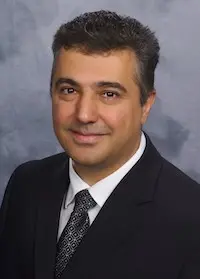In fall 2022, UW-Madison PhD student James Swanke spent several weeks at the NASA Electric Aircraft Testbed (NEAT) facility near Sandusky, Ohio, performing the final tests on a one- megawatt electric aircraft propulsion motor. His extended visit was the culmination of a five-year multi-university research project, a capstone of Swanke’s PhD research and a promising step forward in the field of electrified aviation.
Electric cars, electrified trucks and off-road vehicles such as front-loaders are all moving more rapidly towards wide mainstream adoption, the result of major advances in technologies including cheaper, higher-capacity batteries and more efficient motors. “Greening” aviation, however, is much more difficult. That’s because airplanes require light, energy-dense fuel sources to power their engines. Not only must electric aviation motors be powerful, they must also be light and able to withstand cold temperatures, high altitude and the other extreme operating conditions that are regularly encountered by aircraft.
 Thomas Jahns
Thomas Jahns
To foster the development of cutting-edge aerospace technology, NASA launched the University Leadership Initiative that is currently supporting several multi-university ventures aimed at advancing electrified aircraft technology. The megawatt engine project, spearheaded by Ohio State University and launched in 2017, is one of those projects.
Ohio State invited Emeritus Professor Thomas Jahns and Professor Bulent Sarlioglu, both in electrical and computer engineering at UW-Madison, to join the project team, working on the motor and motor drive configuration. They brought Swanke onboard when he was a master’s student and also enlisted PhD student Hao Zeng to develop the controls for the motor drive.
“For electrified aircraft, you need to pack a lot of power into a small, lightweight electric propulsor. Essentially, we are being asked to challenge the power density of jet engines themselves. The thought of that boggles the mind a little,” says Jahns. “There is a serious long-term challenge of matching the energy density of jet fuel using batteries or hydrogen-powered fuel cells. However, for the propulsor that actually converts the energy into rotary power to get the plane aloft, we’re approaching the point where we can do it. In fact, NASA is challenging us and other universities and companies to show we can actually build electric machines and the power electronics that will put them into the same power density league as jet engines.”
 Bulent Sarlioglu
Bulent Sarlioglu
The team worked on the design of the megawatt motor between 2017 and 2019 and has been constructing it and working out the bugs since then. The key to the design is integrating the power electronics together with the motor into the same enclosure rather than packaging them separately. This is enabled by a new generation of wide-bandgap semiconductor materials including silicon carbide and gallium nitride, which have made it possible to significantly shrink the size of the power electronics.
“We divide our machine windings into multiple three-phase sets, each with its own independent power electronics modules. All of those modules are then integrated into the same enclosure around the circumference of the machine. We then connect multiple power electronics modules in series across a 2000V DC bus to reduce the voltage requirements per module” says Swanke.
There were many other technical breakthroughs as well to deal with thermal issues, improvements in the mechanical strength and shielding of the electromagnets. “We came up with some patentable ideas about how to do these things in ways that haven’t been done before,” says Jahns. “By working together with colleagues at our partner universities, we’ve been able to solve some problems that we would have had trouble solving without their help.”
The team was able to run preliminary tests on the motor at UW-Madison up to 110 kilowatts. At the NASA NEAT facility, however, Swanke and researchers from the other institutions planned to eventually ramp the machine up to its full one-megawatt rating. Getting to that point, however, has required a lot of work. UW-Madison, together with researchers from Ohio State, designed the motor and power electronics and oversaw its construction at the Arnold Magnetic Technologies R&D Center in Middleton, Wisconsin. Colleagues from the University of Maryland and North Carolina A&T State University developed a special cooling system for the motor, which runs at 20,000 revolutions per minute. The Georgia Institute of Technology focused on aircraft optimization and system integration and Ohio State spearheaded work on the battery system and power electronics.
For the final tests, the team members assembled the full integrated motor drive system in the NEAT facility and attached it to a test dynamometer in a vacuum chamber, which simulates high altitude operating conditions that aircraft experience. They tested the machine, gradually pushing up the output torque and speed. They also used a significant number of specialized instruments to monitor the machine’s performance at every operating point, including its efficiency and internal temperature.
While the NEAT testing marked the official end of the megawatt motor project, Swanke sees it as a starting point. “I think it’s becoming pretty clear we can build really light machines,” he says. “But the next question is, how reliable are they? And how can we design them to minimize faults, and then minimize their impact if they happen? That’s what I have focused on during my PhD research.”
He will continue focusing on these issues after graduation in late 2022, when he joins the Denver-based company HX3, a startup developing innovative large-scale integrated motor drives for aerospace applications. H3X was founded by three alumni of the world-renowned Wisconsin Electric Machines and Power Electronics Consortium program at UW-Madison.
Jahns says he’s very proud of the work the multi-university project has accomplished and sees it as just the beginning as well. “I believe the integrated motor drive that we have designed, built, and tested is very close to the global forefront in terms of power density for this kind of electric propulsor system. It’s world-class,” he says. “It may be one step below the power density level achieved by today’s jet engines, but it’s within spitting distance.”
He says the researchers involved in this project are already taking what they’ve learned from the megawatt motor and applying it to even more advanced concepts with high power density targets. While fully electric wide-body passenger aircraft that fly across oceans are likely still decades away, there is a growing likelihood that electric aviation motors will start showing up much sooner in small regional airplanes with either all-electric or hybrid-electric propulsion systems, as well as smaller “air taxi” aircraft with vertical takeoff and landing capabilities.
Featured photo caption: James Swanke inspects the megawatt aviation motor he helped develop at the NASA Electric Aircraft Testbed near Sandusky, Ohio.